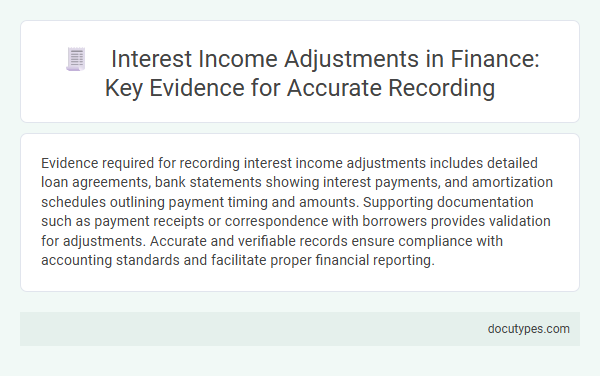Evidence required for recording interest income adjustments includes detailed loan agreements, bank statements showing interest payments, and amortization schedules outlining payment timing and amounts. Supporting documentation such as payment receipts or correspondence with borrowers provides validation for adjustments. Accurate and verifiable records ensure compliance with accounting standards and facilitate proper financial reporting.
Understanding Interest Income Adjustments
Interest income adjustments require accurate and verifiable evidence to ensure compliance with accounting standards and proper financial reporting. Understanding the types of documentation needed helps maintain transparency and supports audit processes effectively.
- Loan agreements - Contractual documents specifying interest rates and payment terms provide primary evidence for recording interest income adjustments.
- Bank statements - Transaction records verifying actual interest received facilitate accurate adjustment entries and reconciliation.
- Amortization schedules - Detailed breakdowns of principal and interest components support calculation and validation of adjusted interest income amounts.
Importance of Accurate Interest Income Recording
Accurate interest income recording is crucial for maintaining the integrity of financial statements and ensuring regulatory compliance. Proper evidence supports adjustments, preventing misstatements that could impact stakeholder trust and investment decisions.
Documentation such as loan agreements, bank statements, and amortization schedules provide necessary proof for interest income adjustments. Supporting calculations and reconciliations further validate the accuracy and completeness of recorded interest income.
Types of Interest Income Adjustments
What types of interest income adjustments require specific evidence for accurate recording? Interest income adjustments may include accrued interest, amortization of bond premiums or discounts, and corrections of prior period errors. Your documentation should support the nature and calculation of these adjustments to ensure compliance with accounting standards.
Common Errors in Interest Income Recognition
Accurate documentation such as loan agreements, transaction records, and bank statements is essential for recording interest income adjustments. Common errors in interest income recognition include miscalculating accrued interest, incorrect application of interest rates, and failing to adjust for payment timing. Ensuring proper reconciliation and verification minimizes discrepancies and maintains compliance with accounting standards.
Regulatory Requirements for Interest Income Reporting
Regulatory requirements for interest income reporting mandate the provision of accurate and verifiable evidence to support any adjustments. Financial institutions must maintain detailed documentation such as loan agreements, payment schedules, and transaction records to ensure compliance.
Auditors often require reconciliations between reported interest income and underlying contract terms to validate accuracy. You should also retain formal communications and correction notices that justify interest income changes for regulatory review.
Methods for Adjusting Interest Income
Accurate evidence is crucial for recording interest income adjustments, ensuring compliance with accounting standards and financial regulations. Supporting documents such as loan agreements, amortization schedules, and bank statements provide the basis for verifying interest calculations.
Methods for adjusting interest income typically include the effective interest method, which amortizes premiums or discounts over the life of the financial instrument, and the straight-line method, applying a consistent rate over time. Detailed transaction records and recalculated interest schedules serve as evidence for these adjustments. You must maintain clear documentation to support any changes in reported interest income during financial reporting periods.
Impact of Adjustments on Financial Statements
| Aspect | Details |
|---|---|
| Type of Evidence | Loan agreements, interest rate schedules, payment receipts, bank statements, and recalculation reports serve as proof for interest income adjustments. |
| Verification Methods | Reconciliation of recorded interest amounts with contractual terms and independent calculation reviews ensure accuracy. |
| Timing Documentation | Accrual dates and adjustment periods must be clearly documented to match interest income with the correct accounting period. |
| Impact on Income Statement | Adjustments affect reported interest income, influencing net income and profitability metrics, which are critical for stakeholder analysis. |
| Impact on Balance Sheet | Changes in interest income result in updated receivables and retained earnings figures, altering asset values and equity balances. |
| Disclosure Requirements | Proper notes and disclosures explain the nature and reasons for interest income adjustments, ensuring transparency in financial reporting. |
| User Consideration | Your financial statement review should focus on how these adjustments affect key ratios and compliance with accounting standards. |
Audit Procedures for Interest Income Adjustments
Audit procedures for interest income adjustments require thorough examination of loan agreements, interest calculation schedules, and supporting financial statements to verify accuracy. Evidence needed includes detailed bank statements, amortization tables, and communication records with borrowers ensuring interest rates and payment terms align with recorded figures. You must also review internal controls and reconciliation reports to confirm proper adjustment entries and detect any discrepancies or fraudulent activities.
Best Practices for Documenting Interest Income
Accurate evidence is crucial for recording interest income adjustments to ensure compliance with accounting standards and regulatory requirements. Proper documentation supports the integrity and auditability of your financial records.
- Loan Agreements - Maintain original loan contracts that specify interest rates and payment terms to validate income calculations.
- Transaction Records - Keep detailed payment schedules and bank statements showing interest receipts for verification.
- Adjustment Justifications - Document written explanations for any interest income adjustments, including recalculations and relevant approvals.
What Evidence Is Needed for Recording Interest Income Adjustments? Infographic

